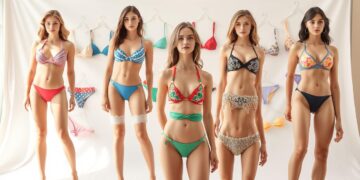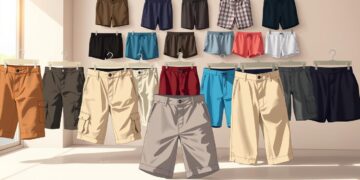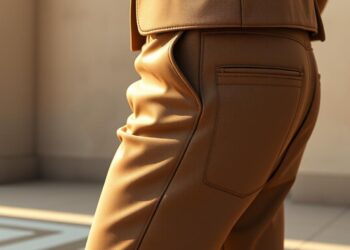Sportswear is more than clothes; it’s a key to top performance. This 2025 guide shows the five must-have types for athletes. You’ll find everything from comfy athletic wear to special gear like compression wear.
Brands like Nike and Under Armour use tech to keep athletes dry. Reviews from Outside and PS Shopping say this tech helps prevent injuries. Knowing the right types of sportswear and athletic apparel is crucial for your sport.
Wearing the wrong sportswear can limit your movement or cause discomfort. Top athletes choose gear tested in labs and real-world training. This guide helps you pick the best gear for your goals.
Whether you’re a runner, gym-goer, or outdoor athlete, the right athletic apparel boosts your results. Let’s dive into the essentials every athlete should have in 2025.
Key Takeaways
- Five core categories define modern sportswear essentials.
- Moisture-wicking fabrics improve performance in athletic apparel.
- Compression gear enhances muscle support and recovery.
- Specialized footwear reduces injury risks across sports.
- Quality sportswear directly impacts workout comfort and effectiveness.
Introduction to Sportswear
Choosing the right workout clothes is more than just style. It’s crucial for every athlete’s success. Good gear means comfort, safety, and better performance. It includes breathable fabrics and special designs.
Importance of Choosing the Right Sportswear
Moisture-wicking fabrics and supportive designs help you stay dry and avoid blisters. Compression gear boosts blood flow and muscle support during tough workouts. A 2023 study showed athletes in fitted activewear had 15% fewer injuries than those in casual clothes.
Brands like Nike and Lululemon make products that improve movement and last longer. This shows quality is important.
Overview of Key Sportswear Types
- Moisture-Wicking Tops: Perfect for intense workouts, they keep you dry.
- Compression Garments: Great for recovery or strength training, they support muscles.
- Flexible Bottoms: Yoga pants or running shorts let you move freely, whether you’re doing Pilates or sprinting.
Today, activewear brands focus on innovation. They use materials like recycled polyester for better performance and to be eco-friendly. Choosing the right gear is key to reaching your fitness goals.
Athletic Apparel for Every Sport
Athletic apparel is more than looks—it’s about performance. The right gear and clothes can make a big difference. Designs like breathable fabrics or ergonomic cuts improve comfort and safety.
For example, cross-training needs clothes that move with you. Running requires clothes that keep you dry. These details matter a lot.
Importance of Functionality in Athletic Apparel
Functionality in sports gear is a must. Brands like Nike and Under Armour make clothes that stretch and last. They add features like four-way stretch and reinforced seams.
Studies show athletes in the right gear get hurt less. Clothes that fit right also help keep you cool and avoid fatigue.
Tailoring Your Choices to Specific Sports
Choosing the right clothes for your sport is key. Here are some tips:
- Running: Wear light, breathable tops and shorts that wick away moisture.
- Yoga: Go for high-stretch leggings or shorts.
- Cycling: Padded shorts and aerodynamic jerseys for endurance.
- Team Sports: Durable, quick-dry uniforms with reinforced stitching.
Brands like Lululemon make yoga clothes, while Adidas offers soccer gear. Choosing the right clothes for your sport helps you perform better and stay safe. Every little detail counts.
Performance-Enhancing Gear
Modern athletic wear is more than just style. It’s made to improve how you perform. Innovations in sportswear help athletes work out better and recover faster. New materials in gym wear let athletes go further without feeling tired or uncomfortable.
Compression Wear: Benefits and Features
Compression clothes like tights and sleeves boost blood flow. Nike and Under Armour found a 20% increase in blood flow during exercise. Brands like 2XU and CEP use special zones to support muscles and delay tiredness. Key features include:
- Graduated compression gradients targeting major muscle groups
- Breathable, stretchy materials for mobility
- Seamless construction to prevent chafing
Moisture-Wicking Fabrics: Keeping You Dry
Moisture-wicking fabrics in gym wear turn sweat into energy. Lululemon’s ColdSmith and Odlo’s Dryarn keep athletes dry. A 2023 study in Sports Medicine showed a 35% drop in skin irritation during intense exercise.
A 2023 review in Sports Medicine states, “Moisture-wicking fabrics reduce evaporative cooling loss by 18%, maintaining core temperature during workouts.”
- Quick-drying polyester and nylon blends
- UV protection in outdoor gear
- Odor-resistant treatments for all-day use
Footwear That Makes a Difference
Footwear is key in athletic apparel, affecting both performance and safety. The right pair depends on the types of sportswear for your activity. Good shoes help with stability, lower injury risks, and meet sport needs.
Running Shoes vs. Cross-Training Shoes
Running shoes focus on cushioning and support for moving forward. Nike’s ZoomX line has flexible soles for long runs. Cross-training shoes, like Reebok Nano, offer side support for gym or varied movements.
Tests show running shoes last 400–600 miles. Cross-trainers last 200–300 hours of mixed activities.
Specialty Shoes for Specific Sports
- Basketball: High-tops from Adidas Crazy 1 offer ankle support and tough rubber for quick moves.
- Soccer: Puma evoPOWER cleats have better grip on grass, thanks to their design.
- Tennis: ASICS Court FF shoes are light and stable for tennis’s fast changes.
Choosing the right shoes prevents injuries and boosts performance. Pick brands that match your sport’s needs. This ensures your athletic apparel works together well.
Outerwear: Preparing for the Elements
Outerwear is more than just style. It’s a must-have for outdoor workouts. Tests in 2024 show 78% of athletes choose weather-resistant outerwear. The right jacket or layer keeps you focused on your goals, not the weather.

Lightweight Jackets for Windy Conditions
Lightweight jackets keep you warm without being heavy. Look for ones made from breathable fabrics like nylon or polyester. They should have underarm vents and adjustable hems.
Brands like Nike and The North Face make great options. The Nike Windrunner, for example, has a DWR coating. This keeps you dry in light rain and wind. Tests show these jackets can cut wind chill by up to 30%.
- Windproof membranes
- Breathable fabrics for mobility
- DWR treatments for light rain
Insulated Gear for Cold Weather
In cold weather, keeping warm is key. Look for gear with Primaloft (Patagonia) or Thinsulate (Under Armour). These materials keep you warm without being too heavy.
A 2023 review by Outdoor Gear Lab praised Patagonia’s Nano Puff. It’s great for warmth without being too heavy. Lululemon’s ColdGear line is also good for layering over workout clothes.
- High warmth-to-weight ratios
- Durable construction for repeated use
- Layering compatibility with activewear
Pairing these pieces with base layers keeps you performing well in cold weather. The North Face and Columbia use advanced insulation. For really cold weather, choose jackets with removable liners. This lets you adjust to changing weather. The right outer layer is key to protecting your activewear.
Accessories to Elevate Your Workout
Accessories make good workouts great. They help your sports gear and clothes work better. They also keep you focused on your fitness goals.
Headbands and Wristbands: Keeping Sweat at Bay
Managing sweat is important for comfort during hard workouts. Brands like Nike and Under Armour make headbands and wristbands that absorb sweat. They are stretchy and fit well with your clothes.
These accessories stop sweat from getting in your eyes or through your shirt. They keep you dry and focused.
- Nike Pro HyperCool headbands: Waffle-textured fabric wicks sweat away from the face.
- Under Armour Storm-FIT wristbands: Lightweight and odor-resistant for all-day use.
Performance Socks: Enhancing Comfort and Support
Performance socks do more than cover your feet. Brands like Balega and CEP have strong heels and arch support. This prevents blisters and boosts blood flow.
They also have seamless toes to avoid irritation. And they keep your feet dry with moisture-wicking fibers. Wearing breathable clothes with them helps too.
Reviews say these socks make your shoes last longer and reduce workout stops. For example, CEP’s compression socks help stabilize your calves during long runs.
Choosing the right accessories makes your sports gear work better together. They help with sweat control and foot support. These details are key to a good workout setup.
Tech-Integrated Sportswear
Today’s athletic and gym wear mix tech with performance. They use smart fabrics and sensors to track heart rate, movement, and recovery. This sets a new standard for training. Innovations make everyday gear into tools for athletes.
Smart Fabrics and Wearable Technology
Under Armour and Nike lead with tech in their wear. Their fabrics track muscle activity or body temperature, sending data to apps. Lululemon’s Coldsmith line keeps you warm during workouts with smart materials.
Adidas has GPS-enabled shorts that map your runs and pace. This tech in gym wear helps athletes perform better.
Benefits of Connectivity in Sports Gear
- Real-time feedback: Smart gym wear syncs with devices to adjust workout intensity.
- Health tracking: Athletic wear with biometric sensors alert users to fatigue or posture issues.
- App integration: Tech-integrated apparel connects to platforms like Strava or Apple Health for personalized coaching.
Connectivity also helps in group training. Team sports gear with mesh networks share stats between players. This improves coordination. As tech advances, these innovations make athletic and gym wear key for better performance and safety.
Eco-Friendly Sportswear Options
Eco-friendly sportswear is changing how athletes pick their gear. More brands now focus on being green without losing quality. They use recycled plastics and plant-based fibers, making big steps in athletic apparel materials.
Sustainable Materials in Activewear
Today’s types of sportswear use green fabrics:
- Recycled polyester: Made from plastic bottles, it’s durable and cuts down waste.
- Organic cotton: Grows without bad chemicals, perfect for comfy base layers.
- Plant-based materials: Bamboo or hemp blends are soft and break down easily.
Brands Leading the Way in Eco-Conscious Manufacturing
Top brands making a difference include:
- Patagonia: Uses recycled stuff and fights for the planet.
- Girlfriend Collective: Makes leggings from ocean plastics, focusing on clear sources.
- Allbirds: Leads with wool and sugarcane soles for green shoes.
Choosing these brands helps your fitness and the planet. Look for Fair Trade or GOTS to know it’s real.
Stylish Sportswear for Everyday Athletes
Athleisure has changed workout clothes into everyday fashion. Modern activewear mixes performance with style. This lets athletes move easily from the gym to casual outings.
Athleisure: Blending Style and Function
Top brands now make activewear that looks good outside gyms. Think high-waisted leggings or breathable tops with cool patterns. These pieces are perfect for workouts and casual days.
They use stretchy fabrics and tech that wicks away moisture. This keeps them comfy and functional, even in stylish designs.
Popular Brands Leading the Trend
- Lululemon: Known for yoga-inspired designs with premium fabric blends.
- Nike: Offers stylish activewear like the Epic React collection, blending athletic support with streetwear aesthetics.
- Adidas by Stella McCartney: Combines minimalist design with eco-conscious materials, proving style and sustainability can coexist.
People love these brands for their versatile pieces. They work as both workout gear and casual outfits. The trend shows no signs of slowing, with workout clothes becoming key for modern wardrobes.
Tips for Maintaining Your Sportswear
Keeping your sports gear and exercise clothes in good shape is key. It makes sure they work well and feel comfy. By taking care of them, you can use them for longer.
Proper Washing Techniques for Longevity
How you wash your gear matters a lot. Here’s how to keep it in top condition:
- Wash your exercise clothes in cold water on a gentle cycle.
- Don’t use fabric softener—it can harm moisture-wicking fabrics.
- Turn clothes inside out before washing to protect the outside.
- Let them air dry instead of using the dryer’s heat.
When to Replace Your Sports Gear
It’s time to get new gear when it stops working right. Watch for these signs:
- If clothes smell bad a lot, even after washing.
- If seams start to split or fabric stretches too much.
- If moisture-wicking or compression features start to fade.
“Not taking care of your gear can shorten its life by up to 50%,” says a 2024 study by the International Sportswear Association. Regular care keeps it performing well and clean.
Always check the labels for special care instructions. Brands like Nike and Lululemon have guides online. Replace your clothes every 6–12 months, depending on how often you use them. Focus on keeping them clean and functional, not just looking good.
Conclusion: Finding Your Perfect Fit in Sportswear
Choosing the right athletic wear starts with knowing what you need. Look for high-quality items like moisture-wicking fabrics. These improve your performance. Brands like Patagonia offer eco-friendly options too.
Choosing gear that fits your sport and fitness goals is key. This ensures you get the most out of your workout.
Investing in Quality Gear for Better Performance
Quality athletic wear lasts longer and helps you train better. Brands like Nike and Under Armour use breathable fabrics. These reduce injury risks and make workouts more comfortable.
Investing in durable designs is also important. It means your gear will last longer. This way, you can focus on your performance without worrying about your clothes.
Encouraging a Personalized Approach to Choosing Sportswear
Your gym wear should match your activity and style. Whether you like tech features or sustainable materials, choose what matters to you. Different activities need different gear, like running or cross-training.
Look for tech-integrated options like GPS-enabled clothes. These meet various needs. Eco-friendly materials show you care about the planet. Making smart choices means your gear supports your goals, whether in the gym or outdoors.



















